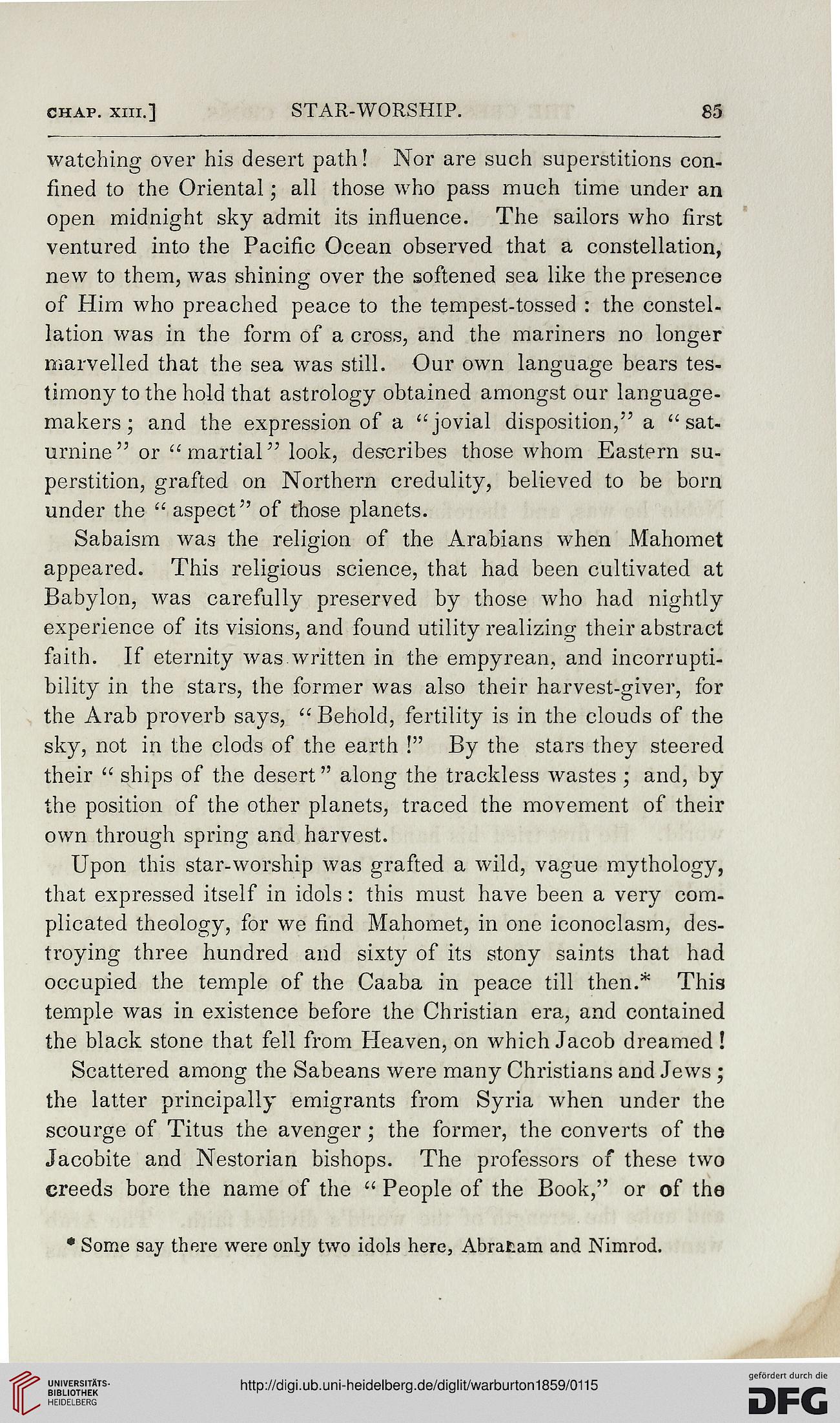CHAP. XIII.]
STAR-WORSHIP.
85
watching over his desert path! Nor are such superstitions con-
fined to the Oriental; all those who pass much time under an
open midnight sky admit its influence. The sailors who first
ventured into the Pacific Ocean observed that a constellation,
new to them, was shining over the softened sea like the presence
of Him who preached peace to the tempest-tossed : the constel-
lation was in the form of a cross, and the mariners no longer
marvelled that the sea was still. Our own language bears tes-
timony to the hold that astrology obtained amongst our language-
makers ; and the expression of a "jovial disposition," a "sat-
urnine" or "martial" look, describes those whom Eastern su-
perstition, grafted on Northern credulity, believed to be born
under the " aspect" of those planets.
Sabaism was the religion of the Arabians when Mahomet
appeared. This religious science, that had been cultivated at
Babylon, was carefully preserved by those who had nightly
experience of its visions, and found utility realizing their abstract
faith. If eternity was.written in the empyrean, and incorrupti-
bility in the stars, the former was also their harvest-giver, for
the Arab proverb says, " Behold, fertility is in the clouds of the
sky, not in the clods of the earth !" By the stars they steered
their " ships of the desert" along the trackless wastes ; and, by
the position of the other planets, traced the movement of their
own through spring and harvest.
Upon this star-worship was grafted a wild, vague mythology,
that expressed itself in idols: this must have been a very com-
plicated theology, for we find Mahomet, in one iconoclasm, des-
troying three hundred and sixty of its stony saints that had
occupied the temple of the Caaba in peace till then.* This
temple was in existence before the Christian era, and contained
the black stone that fell from Heaven, on which Jacob dreamed !
Scattered among the Sabeans were many Christians and Jews ;
the latter principally emigrants from Syria when under the
scourge of Titus the avenger; the former, the converts of the
Jacobite and Nestorian bishops. The professors of these two
creeds bore the name of the " People of the Book," or of the
• Some say there were only two idols here, Abraham and Nimrod.
STAR-WORSHIP.
85
watching over his desert path! Nor are such superstitions con-
fined to the Oriental; all those who pass much time under an
open midnight sky admit its influence. The sailors who first
ventured into the Pacific Ocean observed that a constellation,
new to them, was shining over the softened sea like the presence
of Him who preached peace to the tempest-tossed : the constel-
lation was in the form of a cross, and the mariners no longer
marvelled that the sea was still. Our own language bears tes-
timony to the hold that astrology obtained amongst our language-
makers ; and the expression of a "jovial disposition," a "sat-
urnine" or "martial" look, describes those whom Eastern su-
perstition, grafted on Northern credulity, believed to be born
under the " aspect" of those planets.
Sabaism was the religion of the Arabians when Mahomet
appeared. This religious science, that had been cultivated at
Babylon, was carefully preserved by those who had nightly
experience of its visions, and found utility realizing their abstract
faith. If eternity was.written in the empyrean, and incorrupti-
bility in the stars, the former was also their harvest-giver, for
the Arab proverb says, " Behold, fertility is in the clouds of the
sky, not in the clods of the earth !" By the stars they steered
their " ships of the desert" along the trackless wastes ; and, by
the position of the other planets, traced the movement of their
own through spring and harvest.
Upon this star-worship was grafted a wild, vague mythology,
that expressed itself in idols: this must have been a very com-
plicated theology, for we find Mahomet, in one iconoclasm, des-
troying three hundred and sixty of its stony saints that had
occupied the temple of the Caaba in peace till then.* This
temple was in existence before the Christian era, and contained
the black stone that fell from Heaven, on which Jacob dreamed !
Scattered among the Sabeans were many Christians and Jews ;
the latter principally emigrants from Syria when under the
scourge of Titus the avenger; the former, the converts of the
Jacobite and Nestorian bishops. The professors of these two
creeds bore the name of the " People of the Book," or of the
• Some say there were only two idols here, Abraham and Nimrod.





